|
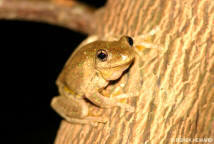
Peron's Tree Frog-
Litoria Peronii
Photograph
- ©Derek Heward
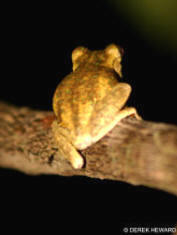
Peron's Tree Frog
Litoria Peronii
Photograph - ©Derek
Heward
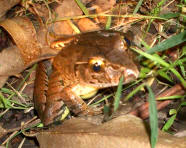
Giant Barred Frog
Mixophyes Iteratus
Photograph - ©Vaughn Nash
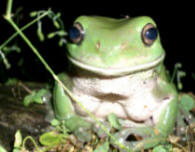
Green Tree Frog
Litoria Caerulea
Photograph - ©Vaughn Nash
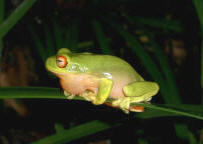
Redeye Green Tree Frog
Litoria Chloris
Photograph - ©Vaughn Nash
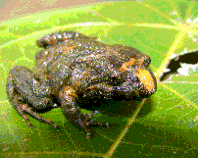
Tusked Frog
Adelotus Brevis
Photograph - © Suzie Pearce

|
Cane Toads are a threat to frogs
through competition for food and
breeding sites and they also predate
on tadpoles and small frogs. |
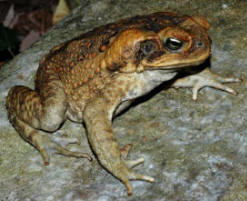
Cane Toad
Bufo marinus
|
Remove cane toads humanely
*
Remove cane toad eggs from ponds (long strands of
black eggs unique to cane toads)
*
Plant local native sedges and reds around pond edges to discourage
toads and as a habitat for frogs (toads don’t jump as high as frogs or
cling onto vegetation)
*
Shading water bodies with local native shade trees helps maintain water
temperatures that frogs prefer for breeding.
*
Ponds of less than 20 cm in depth are more suitable for frogs, as cane
toads prefer deeper water bodies.
From an article by Eva Ford
in the Frogsheet-
Qld Frog Society Newsletter
Winter 2006
|
|
|
|
|
THE LIFE CYCLE
Male frogs call in the breeding season to
attract mates. The eggs of most species are
usually laid in or near water and may be
surrounded by either clear gel (tree frogs) or a
frothy, floating foam (ground frogs). Hatching
will take between 24 hours and several days
depending on the species and temperature. It
should be noted that there are many exceptions
to these rules, but from a backyard pond point
of view, most species conform.
Tadpoles
eat mainly decaying plants, living algae and
drowned insects. They gradually develop hindlegs,
forelegs and lungs allowing them to leave the
water and begin their growth to adulthood. At
this point the tail is resorbed into the body.
It does not “drop off” as many people believe.
The tadpole stage varies enormously from species
to species and depends on temperature, food
supply and competition from other tadpoles. Some
species, such as the Ornate Burrowing Frog can
go through the tadpole stage in as little as 15
or 16 days! Others, such as the Barred Frogs can
take many months.
A Adult frogs mate..
B
Eggs hatch
C Tadpoles grow
D Hind legs develop
E
Front leg emerges
F Other
front leg emerges
Then the tail is absorbed,
the lungs develop and
finally the frog leaves the
water.

Frogs need food, shelter and breeding
opportunities. A heavily vegetated
backyard will provide more resources for a
higher number of frogs than a lightly vegetated
one. Additionally, the greater the
diversity of plants and sheltering sites is, the
greater diversity of frogs will be. High
humidity helps, but this needs to be balanced
with sound water use practice. Collecting
your own rainwater to top up ponds and maintain
garden moisture levels, heavy mulching, and
trickly irrigation will allow greater frog
amenity without impacting on water conservation.
on the other hand, long dry spells will not have
an adverse long term effect on your frog
population.. When it's dry - they just stay
hidden.
Setting up a pond
You will
need:-
1. Plastic pond liner
2. Washed sand or
gravel
3. Ledge for plants or rocks
4.
Water depth to 20 cm
5. Rocks, logs
6.
Native water plants
Above Ground Ponds:
Any clean non-metallic container can be used.
Tadpoles prefer shallow water with a large
surface area. Toddlers ‘clamshell’ wading pools
are suitable.
Position:
Tadpoles are heat sensitive. A position which is
predominantly in the shade is best. Frog
choruses at night can be quite loud and can
disturb some people. Talk to the neighbours
before choosing the pond’s position.
Water:
Rainwater is best, but tap water can also be
used quite safely if left to ‘cure’ a few days
in sunlight before using to top up ponds or
establish a new one.
WATER is No: 1 need to frogs.
PLEASE, be waterwise!
What you can and can’t do to frogs
♦
There is a Nature
Conservation Act and two Conservation
Regulations that apply to frogs and they need to
be read in conjunction with each other
(over 700 pages )
♦
The
definition of wildlife
includes eggs, larvae or any part of any animal.
♦ It
is prohibited to take any protected animal, with
varyi ng classes of offences if they are
taken. The taking of any frog, egg or tadpole is
illegal without a permit licence or other
authority.
♦
There
is however an exemption. The exemption applies onl y to frogs which are declared to be Common
Wildlife.
If you do not have a licence (like most of us),
you can take up to 8 frogs and up to a maximum
of 2 species of any one species if they are
declared common.
Tadpoles
and eggs cannot be taken.
♦
The
problem is, there is no such Common Frog List!
You therefore need to assume that if a species
is not listed as Extinct, Endangered, Vulnerable
or Rare, then it must be common.
♦
These
exempt frogs can only be taken from the backyard
that they are to be kept in!
(does that make sense??? It sounds to me,
that means you cannot transport them from your
backyard).
So, what does this mean? It means we cannot have
a display of live frogs at the Frog Festival
unless someone has a permit.
If you would like to delve into this marvellous
world of legislative legalise a little more,
visit the Nature
Conservation legislation at
www.legislation.qld.gov.au.
Hop to top of page
|
|
|
|
FAVOURITE THINGS FOR FROGS
1.
Water—Unpolluted and abundant for
living and breeding.
Frogs need a diversity of water body formations
found naturally with creeks and wetlands. They are very sensitive to toxins
and other pollutants.
2.
Food—Lots of invertebrates (the
essential element for most food chains)
Healthy unpolluted creeks,
rivers and wetlands provide the greater diversity and abundance of
invertebrates
3. Shelter—Moist
microhabitats, vegetation, leaf litter, logs.
Natural places such as
rainforest, streambanks, wetlands, and wallum are important habitat areas
for frogs. If such places are removed or disturbed, frogs living there are
likely to be lost.
Gardens can be made more frog-friendly where
natural habitat has already been removed and this can be important for frog
survival. Frogs need a diversity of vegetation types (preferable local
native) and
sheltering sites (logs, leaf litter). Ponds for breeding and
moist mulched areas are also important with water collected by rainwater
tanks being ideal. Tadpoles prefer shallow water with a large surface area.
Keeping smaller variety native fish (e.g
Pacific Blue Eyes) in ponds is helpful
for mosquito control. Keep pets secure particularly at night.
4. Mates—Opposite
sex of the same species preferred
5. Peace—Not
to be moved, eaten, captured, tortured, diseased, out-competed or poisoned
Domestic animals and foxes are a direct
threat to frogs.
It is important not to take frogs or tadpoles from the wild for pets, as
disturbance is a serious threat to their existence.
Handling frogs or tadpoles can spread the chytrid fungal disease that is
threatening whole populations of frog species.

|
Bank / Edge |
Native
Ginger |
Alpinia
caerulea |
River
Lilly |
Crinum
pedunculatum |
| Lomandra |
Lomandra
hystrix
longifolia
Other local species |
Coastal
flax lilly |
Dianella
congesta
Other local species |
|
Water
edge / in water/Amphibian
Make sure local species are chosen
Check species, as some
can be invasive |
| Phragmites |
diverse
local species |
| Typha |
diverse
local species |
| Cyperus |
diverse
local species |
| Juncus |
diverse
local species |
| Baumea |
articulata
&
rubiginosa |
| Bolboschenus |
diverse local species |
|
In Pond |
Snowflake
Lilly
|
Nymphoides indica
|
|
This is only a list of some
species,
more species may also be useful
Vaughn Nash
Maroochy Waterwatch
|
|
Native
Fish for frog ponds |
|
We highly
recommend:-
Pacific blue eye
- up to 30mm
Others to try:-
Firetail gudgeon
- up to 65 mm
Crimson-spotted Rainbow
- up to 120mm
The larger size fish over
30mm may eat tadpoles, so you may wish to separate them
until tadpoles have reached a sufficient size
"White Cloud"
are not
native fish
PLEASE AVOID THESE
Queensland
Frog Society
www.qldfrogs.asn.au
|
|
|
|
|
|

